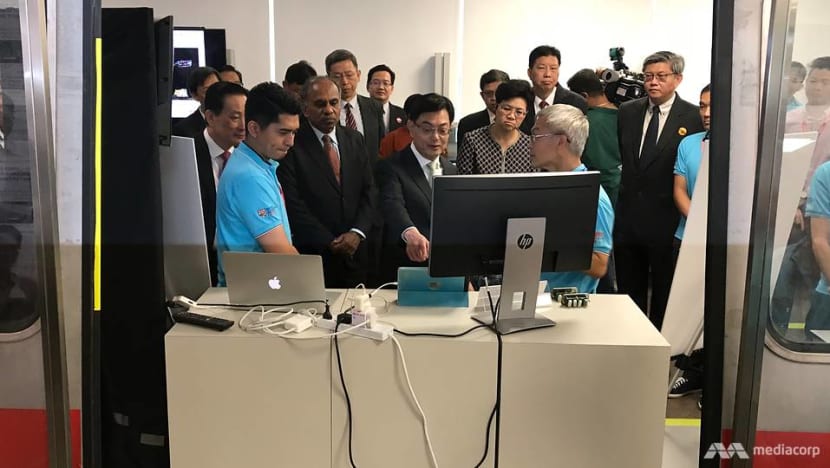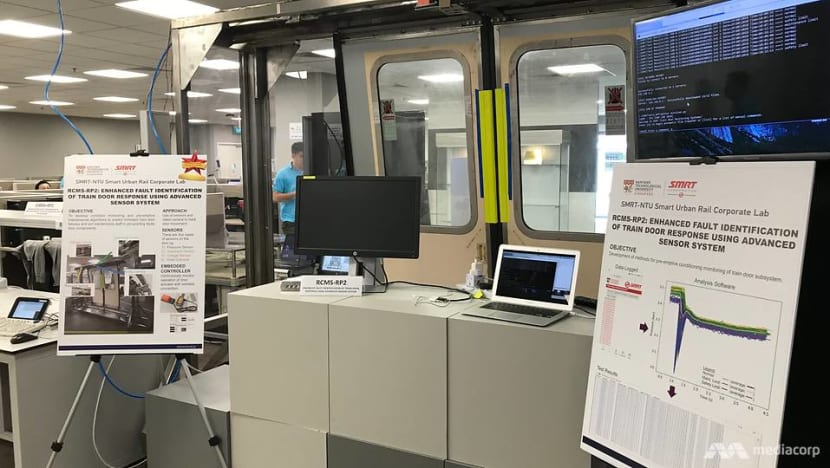SMRT, NTU develop new systems to detect train door faults, enhance rail reliability

The lab was officially opened on Wednesday (Aug 29) by Minister for Finance and NRF chairman Heng Swee Keat. (Photo: Elizabeth Neo)
SINGAPORE: A sensor system that can detect MRT train door faults and alert engineers has been on trial since June this year - one of four projects that will be progressively implemented in phases to enhance rail reliability.
They are part of 13 projects in a joint research collaboration between transport operator SMRT and Nanyang Technological University (NTU), under the S$60 million SMRT-NTU Smart Urban Rail Corporate Laboratory established in May 2016, with support from the National Research Foundation (NRF).
The lab was officially opened on Wednesday (Aug 29) by Minister for Finance and NRF chairman Heng Swee Keat. It focuses on two complementary research tracks - developing real-time monitoring systems and enhancing the reliability of existing rail assets. It pools together NTU researchers and SMRT staff.
Speaking at the launch, Mr Heng said: “This corporate laboratory aims to drive the effective translation of research into solutions that have direct relevance not just to SMRT, but to the global transport industry in anticipation of future needs.
"It looks forward to technical issues that will affect transport systems of tomorrow, and directs the R&D today to develop solutions.”

One of the projects being tested on a train on the North-South and East-West Lines is the Advanced Train Door Sensor System.
When mounted onto train doors, the sensors record air pressure, movement speed and power systems. The sensors also come with algorithms that can predict imminent train door failures, and allow engineers to identify faults and reduce the time needed for troubleshooting.
More than half of all train delays are caused by door faults.
Another project is a cladding system that uses laser technology to repair defective rails along the tracks. The system can be mounted on wagon wheels to carry out rail steel repair works in a less labour-intensive manner. It also reduces the time taken to carry out the repairs to a single night compared to three nights currently. The system is expected to be deployed for trial in 2019.
Within the next two years, systems that can pick up defects on the power rail and running rails, as well as one that can inspect train axles, will be tested.
Mr Heng said the projects “will result in better management of train door faults, significant cuts in delays, faster and smarter track repairs, better-maintained trains and higher service levels”.
SMRT chief executive Neo Kian Hong said the company is working to improve rail reliability and sustain the progress made. “At the same time, we will tap top-notch engineering resources in Singapore to solve problems that affect our train services, such as train door, track or power supply issues," he added.
Said NTU president Professor Subra Suresh: "Using latest sensor technology, radio frequency technology, 3D printing and many other tools, we have an opportunity to take cutting-edge research to solve immediate problems of interest to millions of commuters in Singapore - who are the end users of these technology.”
The SMRT-NTU Smart Urban Rail Corporate Laboratory is one of 12 labs supported by the NRF, which facilitates the setting up of corporate labs via public-private partnerships.












